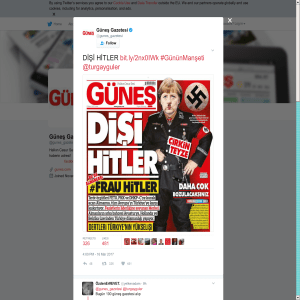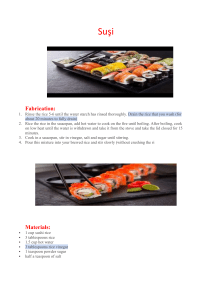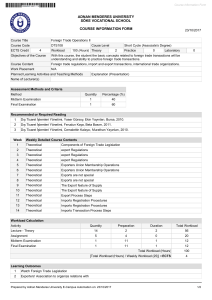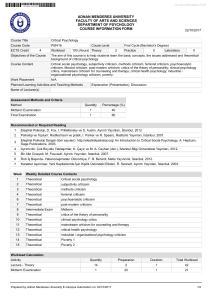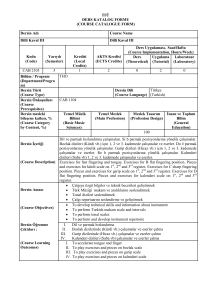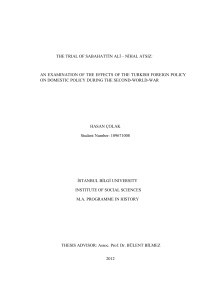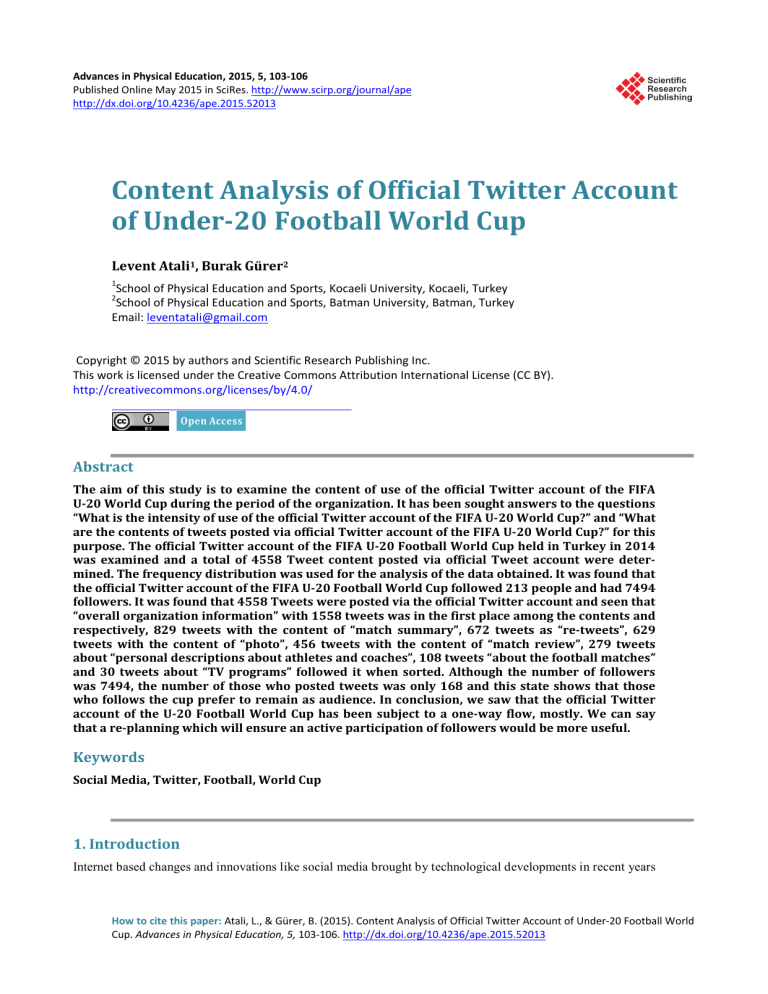
Advances in Physical Education, 2015, 5, 103-106
Published Online May 2015 in SciRes. http://www.scirp.org/journal/ape
http://dx.doi.org/10.4236/ape.2015.52013
Content Analysis of Official Twitter Account
of Under-20 Football World Cup
Levent Atali1, Burak Gürer2
1
School of Physical Education and Sports, Kocaeli University, Kocaeli, Turkey
School of Physical Education and Sports, Batman University, Batman, Turkey
Email: [email protected]
2
Copyright © 2015 by authors and Scientific Research Publishing Inc.
This work is licensed under the Creative Commons Attribution International License (CC BY).
http://creativecommons.org/licenses/by/4.0/
Abstract
The aim of this study is to examine the content of use of the official Twitter account of the FIFA
U-20 World Cup during the period of the organization. It has been sought answers to the questions
“What is the intensity of use of the official Twitter account of the FIFA U-20 World Cup?” and “What
are the contents of tweets posted via official Twitter account of the FIFA U-20 World Cup?” for this
purpose. The official Twitter account of the FIFA U-20 Football World Cup held in Turkey in 2014
was examined and a total of 4558 Tweet content posted via official Tweet account were determined. The frequency distribution was used for the analysis of the data obtained. It was found that
the official Twitter account of the FIFA U-20 Football World Cup followed 213 people and had 7494
followers. It was found that 4558 Tweets were posted via the official Twitter account and seen that
“overall organization information” with 1558 tweets was in the first place among the contents and
respectively, 829 tweets with the content of “match summary”, 672 tweets as “re-tweets”, 629
tweets with the content of “photo”, 456 tweets with the content of “match review”, 279 tweets
about “personal descriptions about athletes and coaches”, 108 tweets “about the football matches”
and 30 tweets about “TV programs” followed it when sorted. Although the number of followers
was 7494, the number of those who posted tweets was only 168 and this state shows that those
who follows the cup prefer to remain as audience. In conclusion, we saw that the official Twitter
account of the U-20 Football World Cup has been subject to a one-way flow, mostly. We can say
that a re-planning which will ensure an active participation of followers would be more useful.
Keywords
Social Media, Twitter, Football, World Cup
1. Introduction
Internet based changes and innovations like social media brought by technological developments in recent years
How to cite this paper: Atali, L., & Gürer, B. (2015). Content Analysis of Official Twitter Account of Under-20 Football World
Cup. Advances in Physical Education, 5, 103-106. http://dx.doi.org/10.4236/ape.2015.52013
L. Atali, B. Gürer
have cr eated some changes a nd ef fects. S uch changes a nd effects have changed manufacturing and marketing
activities, sales strategies, and competition techniques of enterprise as well as relevant instruments used by these
enterprises (Ünal, 2011). A giant social sharing platform with an unprecedented scale and easiness has come into our life with social media (Kahraman, 2010). Blossom (2010) defined social media as a h ighly scalable and
accessible communications technology or technique that enables any individual to influence groups of other individuals easily.
The basic reason for using social media is that it interconnects individuals. Social media also enables enterprises to communicate, cooperate and share important knowledge necessary for performing their tasks in a better
and quick manner (Jue, Alcalde, & Kassostakis, 2010). Besides these reasons, consumers use social media for its
several ad vantages. S ocial media enables s everal sports s upporters to co mmunicate t hrough these ad vantages
(Aşman & Kılıç, 2011). Fouts (2009) mentioned that there are several ways of busy oneself in social media and
that many social media i nstruments have be en de veloped f or t his pu rpose. S ocial media a pplication n amed
“twitter” is one of these media instruments.
Social media instruments like Facebook, Twitter and blogging sites have become efficient in sports field like
other f ields o f l ife. P articularly F acebook an d T witter act ivates t he co mmunication b etween at hletes, s ports
clubs and supporters. Athletes now use social media for knowledge sharing (Çavuşoğlu, Öztürk, & Kara, 2011).
Sports s upporters d esire t o have hi gher q uality p hotographs a nd k nowledge with ne ver-before-seen s peed.
Sports supporters also want to acquire sport-related information and other elements from different sources. New
technology provides this opportunity by establishing direct communication for supporters (Atalı, 2003). Hall et
al. (2007) sport o rganizations an d s upporters will al ways have t o d evelop n ew ef fective co mmunication t echniques, and computers will play the vital role.
Social media instruments are an efficient way of communication for athletes, coaches, teams, and leagues that
increases its importance gradually. Argan and Katırcı (2002) stated that sport marketing has changed its form by
new technologies, and supporters have become more interactive. The importance of internet has increased since
sport became a global product; and internet use in sports field has also increased.
As internet use b ecame widespread in sports field, co mmunication has b ecome easier and tribunes were i nfluenced by new communication ways. That supporters are informed about their own tribunes as well as other
tribunes shows that internet is used extensively in providing effective participation in organizations (Hatipoğlu
& Aydın, 2007).
Sport industry has opened its doors to innovation by using recent technologies. Expectations of athletes and
supporters today cause technology and sport to become interlocked (Devecioğlu & Altıngül, 2011). New technologies have increased the number of supporters in s ocial media and created a new supporter group. In this
context, new technologies have an important effect on sports (Rein & Kotler, 2006). The effect of social media
and social media instruments on increasing the number of supporters has reached a challenging size.
2. Aim of the Study
The aim of this study is to examine the content of use of the official T witter account of the FIFA U-20 World
Cup during the period of the organization. It has been sought answers to the questions “What is the intensity of
use of the official Twitter account of the FIFA U-20 World Cup?” and “What are the contents of tweets posted
via official Twitter account of the FIFA U-20 World Cup?” for this purpose.
3. Method
The method used in the study is the content analysis that is one of the qualitative research methods. Content
analysis is the type of analysis that is used to measure variables in a text systematically, objectively and quantitatively (Wimmer & Dominick, 2000). The state that exists in this study was examined impartially.
The content of use of the official Twitter account of the FIFA U-20 World Cup during the period of the organization constitutes the field of use. Tweet accounts of 7494 people following the official Tweeter account of
the organization during the o rganization an d 4558 Tweet content p osted via official Tweet account were examined. Data obtained by content analysis within the scope of the study were analyzed by using descriptive statistical methods [percentage and frequency].
4. Findings
As the result of the examination of Table 1, it was found that organization posted 4558 tweets and the account
104
L. Atali, B. Gürer
of th e o rganization f ollows 213 p eople a nd th e T witter a ccount o f th e o rganization was f ollowed b y 7 494
people.
As the result of the examination of T weeter contents in Table 2, it w as found that “overall organization i nformation” with 1 558 t weets t ook t he l ead a nd t hen “match s ummary” with 8 29 tw eets, “retweet” with 6 72
tweets, “photo” wit 6 29 tw eets, “match r eview” with 4 56 tw eets, “personal d escriptions ab out at hletes an d
coaches” with 279 t weets, “about the f ootball m atches” with 180 t weets and “TV programs” with 30 t weets
were ranged respectively.
As the result of the examination of Table 3, the number of people posted Tweets out of the followers of the
organization’s official account was found 168 and number of Tweets posted by them was found 659.
5. Discussion and Result
The content of use of the official Twitter account of the FIFA U-20 World Cup during the period of the organization was examined by this study and it has been sought answers to the questions “What is the intensity of use
of the official Twitter account of the FIFA U-20 World Cup?” and “What are the contents of tweets posted via
official Twitter account of the FIFA U-20 World Cup?” for this purpose.
Football is one of the world’s most popular sports with its simple rules and easy access to the equipments required for to play football (Orazio & Leo, 2010). Even the smallest detail to develop football in the developing
world is being shed light on and various studies are being conducted to increase the game speed, ratio of goals
and make football a g ame pleasing to the eye (Kanat, 2007). Posted 4558 tweets within the scope of the study
and number of people posted tweet during the organization was only 168 pe ople may be interpreted as the fact
Table 1. Twitter account.
f
Tweets
4558
Followed (U20 Org.)
213
Followers (person)
7494
f = frekans.
Table 2. Tweet contents of the U20 Organization.
f
%
Overall organization information
1558
34.18
Match summary
829
18.18
Retweet
672
14.74
Photo
629
13.79
Match review
456
10.00
Personal descriptions about athletes and coaches
276
6.05
About the football matches
108
2.36
TV Programs [organization]
30
0.65
TOTAL
4558
100
f = frekans.
Table 3. Twitter statistics of followers.
f
Number of people posted tweets
168
Number of total tweets posted
659
f = frekans.
105
L. Atali, B. Gürer
that the interest on the organization was not so much when considering the football audience in Turkey. The results of the study show that Under-20 Football World Cup seems to have not drawn the interest of so many followers.
Thus, the study to refer to a different point in terms of football is important. Under-20 Football World Cup did
not attract the attention of football audience in Turkey. The insufficient level of promotion or of the interest of
supporter group to a m edia such as T witter may be shown as a cau se to that fact. It can be concluded that the
lack of football players known throughout the world may have negatively affected the Under-20 Football World
Cup and thus, influenced the tweets posted accordingly. Posted 1558 tweets related to the organization make us
think that athletes were not followed so much. That only 276 tweets posted related to football players shows that
young athletes are being followed less than expected.
In conclusion, Under-20 Football World Cup has become an organization during which many tweets were
posted in issues such as match reviews, personal descriptions about athletes and coaches and about the football
matches and TV programs. Many researches were conducted in the field of football in the last ten years in order
to perfect the techniques and make them consistent and reliable and to develop valid methods. Especially the researches to be conducted for young athletes are important in order to draw their attention to that sports branch at
a young age.
Better promotions and introductions are required especially to create and draw attention to the organizations
where young players take place and diversification of studies and researches related to the organizations where
young players take place will be important for the development of football.
References
Argan, M., & Katırcı, H. (2002). Sports Marketing. Ankara: Nobel Yayınları.
Aşman, Ö., & Kılıç, A. (2011). Public Relations 2.0 New Sharers, New Technics in Social Media. Ankara: Elif Yayınevi.
Atalı, L. (2013). Facebook Usage of Turkish Football Federation Spor Toto Super League Sports Clubs and Their Fans.
Doctoral Thesis, Bolu: Abant İzzet Baysal University, Graduate School of Social Sciences.
Blossom, J., Content Nation. (2010). Surviving and Thriving as Social Media Changes Our Work, Our Lives, and Our Future. http://www.contentnation.com
Çavuşoğlu, B., Öztürk, G., & Kara, B. (2011). The Strategic Importance of Internet Usage as New Media Tool in the Studies
of S ports M arketing: Analysis of S ports C lubs’ W ebsites i n T urkey a nd E ngland. The International Journal of Human
Sciences, 8, 1343-1363.
Devecioğlu, S., & Altıngül, O. (2011). Innovation in Sports Technologies. 6th International Advanced Technologies Symposium [IATS’11], 16-18 May 2011, Elazığ.
Fouts, J. (2009). Social Media Success! Practical Advice an Dreal World Examples for Social Media Engagement. California:
HappyAbout.info.
Hall, A., Nichols, W., Moynahan, P., & Taylor, J. (2007). Media Relations in Sport. Morgantown: FIT.
Hatipoğlu, D., & Aydın, B. (2007). Push Ankaragücü: City, Identity, Industrial Football and Fun. Ankara: Epos Yayınları,
270.
Jue, A., Alcalde, J., & Kassostakis, M. (2010). Social Media at Work. San Francisco: Jossey-Bass.
Kahraman, M. (2010). Social Media, Introduction to Social Media for Marketting Experts. İstanbul: Mediacat Yayınları.
Kanat, Ş. Y. ( 2007). T he E ffects of t he M aximal S trength T raining E xercised on t he M uscle of Upper E xtremite on t he
Throw in Distance in Soccer. Ankara: Graduate School of Health Sciences, Gazi University, Yüksek Lisans Tezi.
Orazio, T. D., & Leo, M. (2010). A Review of Vision-Based Systems for Soccer Video Analysis. Pattern Recognition, 43,
2911-2926.
Rein, I., & Kotler, P. (2006). Here Supporter Is, Here Marketing Is. İstanbul: Medicat Yayınları.
Ünal, S. (2011). Customer Relations and Information Technologies in New Economy. İstanbul: Beta Yayınları.
Wimmer, D. D., & Dominick, J. R. (2000). Mass Media Research: An Indroduction. Belmont: Wadsworth Publishing Company.
106

